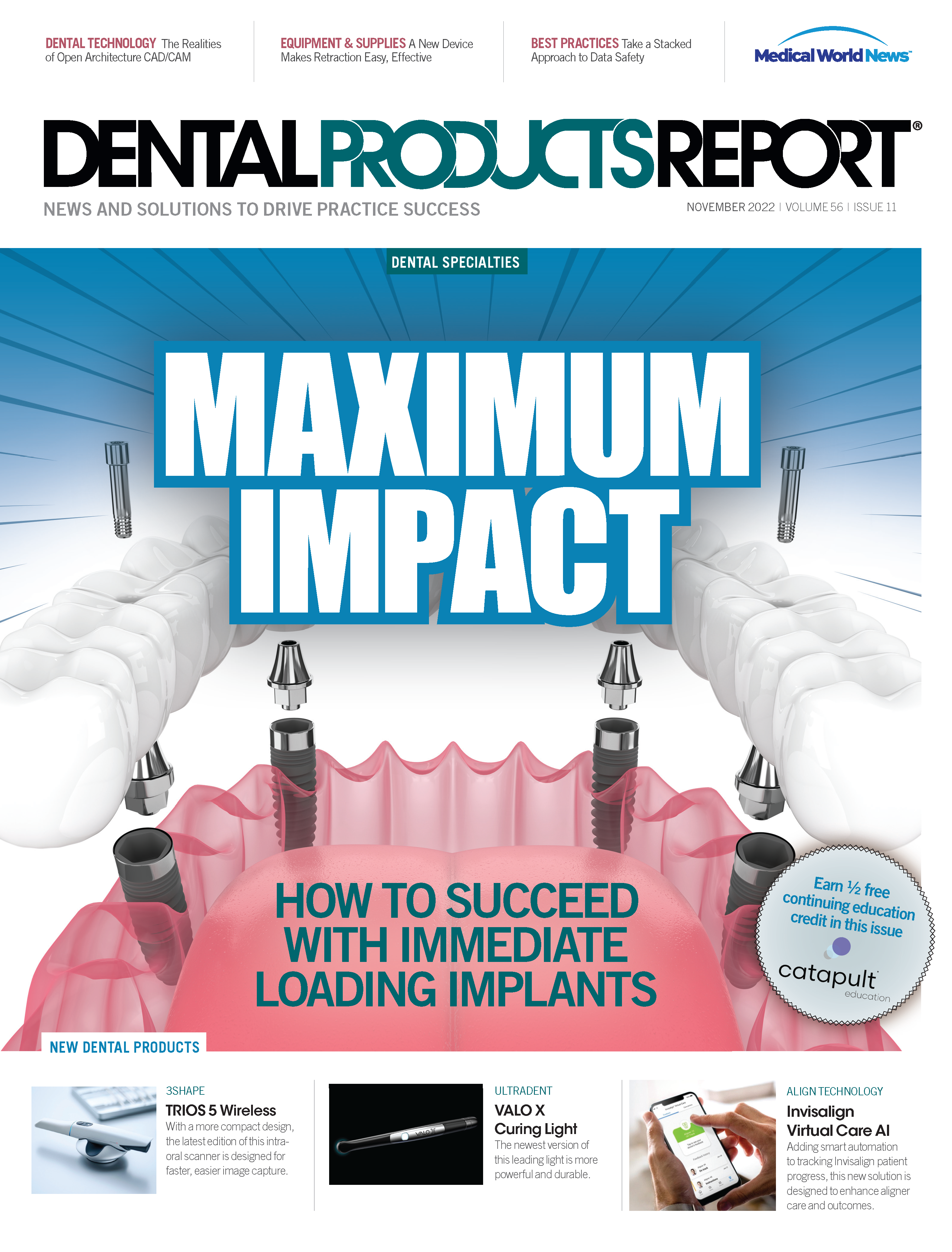Identifying Patients for Ortho Treatment
Dentists should educate the public about the different treatments available, and the improved outcomes.
RH2010 / STOCK.ADOBE.COM

If you’re looking for candidates for orthodontic treatment, research says you don’t need to look far. In various studies over the past 2 decades, researchers have consistently identified the staggering need for orthodontic intervention. They have found 53% of Americans and up to 93% of children and adolescents worldwide present with some sort of malocclusion,1,2 75% would benefit from orthodontic treatment,3 and only 35% of adults in the United States have well-aligned mandibular incisors.4
This means several mouths would benefit from orthodontics. Although many patients view orthodontics as a cosmetic tool (which it can be), there are important medical advantages to well-aligned dentition. Caries, tooth loss, premature occlusal wear or incisal chipping, periodontal disease, temporomandibular joint (TMJ) disorders, and psychological repercussions are all potential adverse effects of malocclusions. Additionally, unmanaged malocclusions can lead to problems down the road when a patient requires restoration work such as veneers or crowns, because favorable alignment, occlusion, spacing, and gingival margins are key for restoration success.
However, only a small percentage of the population in need of orthodontic treatment receives it. The general practitioner needs to discuss orthodontic treatment with patients and the options available to them, especially because the idea of undergoing orthodontic treatment can be daunting for many patients. With the common perception of such treatment being years of bracket adjustments, expanders, headgear, and retainers, it’s no wonder patients feel intimidated or discouraged by the idea of orthodontics.
However, with numerous options on the market ranging from traditional braces to clear aligners, there are more treatment modalities to better accommodate a patient’s needs, making the industry more approachable and accessible. Before you can get to the treatment stage, however, you need to identify the patients who may benefit and how orthodontics could benefit them.
Where to Begin
What should GPs be looking for? Malocclusions come in different forms, classes, and severities, and understanding the differences can affect how to proceed.
“The first step is to look at a case as a full-mouth reconstruction,” Alyssa Emory-Carter, DDS, says. She is an orthodontist in private practice in Sherman, Texas. “List out the signs and symptoms seen in the dentition. Then understand the underlying cause of the issues at hand. There are 3 dimensions skeletally and dentally to evaluate; a detailed, comprehensive diagnosis is the key to an accurate treatment plan and positive result.”
One way to identify and monitor these signs or symptoms is to document everything. Taking digital images at every visit gives clinicians a visible baseline of dental progression. Newly developed incisal chipping, occlusal wear, or buccal abfractions could be clear signs of the adverse effects of a patient’s malocclusion. Listening to patients and keeping clear records of symptoms is also critical; complaints of increased jaw pain or teeth grinding may indicate that a malocclusion requires intervention.
“Every patient who walks through [the] door should have a smile assessment,” Jody Rodney says. Rodney is senior vice president of marketing and education for orthobrain. “Every patient should be asked how they feel about their smile, with a focus not only on esthetics but also the patient’s health.”
Rodney believes starting this evaluation right away is the best practice. She recommends beginning the conversation about orthodontics in the hygiene chair. “Identify the patient and ask them how they feel. Eighty percent of the time, these talks take place in the hygiene chair. Talk about the health benefits of straighter teeth; that typically will send the patient into the next wave of ‘All right, I’d like to listen.’”
Getting patients to listen is critical. Many patients may not know their jaw pain (ie, TMJ issues) is caused by malocclusions that can be remedied through orthodonture. Because patients don’t have this knowledge, it’s up to the general dentist to identify these issues and suggest treatment when necessary.
What to Look For
With malocclusions being so common, it comes as no surprise that there is an endless variety of presentations. Divided into 3 different classes, malocclusions are evaluated based on their severity, which affects whether a patient can be treated with traditional orthodontics or surgical intervention.
Class 1 malocclusion
The least severe of the classes, a class 1 malocclusion occurs when the upper teeth slightly overlap the lower teeth in a good position (a typical bite), but overcrowding, spacing issues, rotations, or protrusion/retrusion of teeth are present. This is often caused by thumb sucking or prolonged bottle or pacifier use as a child and generally doesn’t affect a patient’s bite. It can usually be addressed through minor malocclusion treatment. Class 1 malocclusions are the most common, presenting in up to 93.6% of cases.1
Class 2 malocclusion
A class 2 malocclusion, also called a retrognathism (or overbite), is when the upper teeth overlap the lower jaw and teeth severely, affecting a patient’s bite. class 2 issues are generally caused by having a small lower jaw and are genetically inherited. However, like class 1 malocclusions, they can be exacerbated by thumb sucking, etc. Treatment is generally more extensive and involved than with class 1 malocclusions. class 2 malocclusions present in up to 44.7% of cases.1
Class 3 malocclusion
Also known as a prognathism or underbite, a class 3 malocclusion occurs when the lower jaw protrudes forward, resulting in the lower jaw and teeth overlapping the upper jaw. Like class 2 malocclusions, class 3 issues can be inherited and are caused by insufficient growth of the upper jaw, overgrowth of the lower jaw, or some combination of the two. As the rarest of the 3 classes, class 3 malocclusions occur in only 1.4% to 19.4% of cases.1
Within these classes, different types of malocclusions may present, including the following:
Overcrowding: Commonly caused by a lack of space for teeth, overcrowding results in overlapping or crooked teeth, producing hard-to-brush areas. It can lead to buildup of plaque, tartar, and bacteria, which in turn lead to gum disease or caries development. A 2021 World Health Organization (WHO) study found that in all malocclusion issues, overcrowding presented most frequently, with a prevalence of up to 84%.1
Gapped teeth or diastema: Gaps or spacing issues, such as diastema, can cause teeth to fit improperly in the jaw. The WHO study found spacing issues were the second-most frequent malocclusion anomaly, appearing in 60% of cases.1
Protrusion/overjet: An overjet (ie, protrusion/excessive flare of the upper front teeth) results in the front teeth extending beyond the lower teeth horizontally. This prevents the front teeth from functioning properly, interferes with chewing and speaking, and leads to premature wear. Although uncommon, this malocclusion presented in up to 18.07% of the population studied in the WHO research.
Overbite: Overbites, similar to overjet, can cause improper functioning of the front teeth. However, in severe cases of overbite, the lower front teeth making contact with the upper palate can cause gum recession and result in unusual enamel wear.
Underbite: Also known as anterior crossbite, underbite occurs when the lower front teeth are positioned farther forward than the upper front teeth. Prognathisms may cause a patient to have a bulldog-like appearance, and severe cases can cause difficulty biting and chewing as well as jaw or face pain due to the jaw’s misalignment.
Open bite: An open bite occurs when the front lower and upper teeth are aligned improperly and slant outwards, preventing them from touching when the mouth is closed. This is caused by thumb or pacifier sucking, jaw development problems, tongue thrusting, or TMJ disorders.
Crossbite: Crossbites occur when 1 or more of the upper teeth are trapped inside or behind the lower teeth. If left unmanaged, crossbites can result in gum recession, difficulty chewing, enamel wear, and asymmetrical jaw growth in children. Patients with a crossbite presented in up to 38.4% of cases.1
Moving Forward
Once an issue has been identified, dentists can assess and determine whether it can be handled with clear aligner support options (such as On Demand Orthodontist, SoftSmile, and orthobrain) available to the GP or whether it is a more complex case that needs to be referred to an orthodontist. “Support is essential,” Rodney says. “Dentists who want to enter the clear aligner industry need to partner with an organization that treats them as if they [were] the most important doctor within their matrix so that they can get the full support they need.”
This support is essential because many GPs may not have the knowledge base to accurately assess or fully manage a case. Dr Emory-Carter says careful identification of the malocclusion and an understanding of the end goal are critical in successful treatment planning. This becomes increasingly important as more GPs begin to offer in-house clear aligner treatment. But in some cases, traditional braces—metal, ceramic, self-ligating, or lingual—may be the necessary solution. Clear aligners are great for touch-up cases or correcting mild to moderate misalignments or diastemas, but comprehensive treatments or difficult malocclusions may require more in-depth intervention or 2-phase orthodontics.
Dentists dipping their toes into in-house orthodontic treatment should make sure they understand which option a case requires so they don’t get in over their heads on a complicated case that should have been referred. “There must be an understanding of the physiological limitations,” Dr Emory-Carter says. “When deciding between clear aligners or traditional braces, it is imperative to understand they have different physiological and biomechanical systems, as well as patients’ ability to cooperate.”
